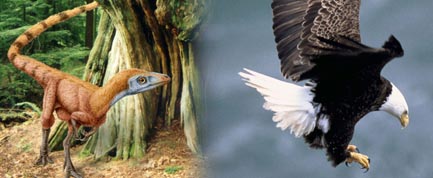Origin of Birds Debated

Birds are living dinosaurs, nearly all scientists agree, but a debate still continues about when that first early bird glided or flew into the Mesozoic scene.
Paleontologists who study fossils think the first modern birds evolved from dinosaurs about 60 million to 65 million years ago, right about the time most dinosaurs went extinct. But biologists who investigate DNA measure the origin of birds at about 100 million years ago.
Scientists hoped that a new study analyzing all of the available genetic data with new statistical models might narrow the gap, but instead it has reinforced it and definitively put the DNA-dating estimate at 100 million years ago.
"It's a robust estimate now," said Joseph Brown, a biology graduate student at the University of Michigan who led the study. "We know that this gap between the fossil record and the molecular data is a real gap. In the past people in both camps would just assume that the other side had gotten it wrong. But it seems now that the discrepancy is really genuine."
The research was published online Jan. 28 in the journal BMC Biology.
Inherent errors
There are problems associated with both methods of dating.
Get the world’s most fascinating discoveries delivered straight to your inbox.
The fossil record is never complete — just because diggers have yet to find fossils of birds from earlier than roughly 65 million years ago doesn't mean there were none.
It's also possible there are errors in the way scientists analyze DNA to discover when species emerged. The technique involves comparing genetic differences among birds to estimate how long ago they diverged as new species. Although genetic mutations occur at random, if studied over large periods of time, they seem to occur periodically.
"If we know, for example, that DNA sequences diverge by an average of two percent every million years, and we determine that two species differ genetically by ten percent, we can figure out that they last shared a common ancestor five million years ago," Brown said.
The problem is, the periodic rate of mutation may vary among lineages, so if scientists apply a single rate to an entire genetic tree, they may miscalculate.
The new study aimed to compensate for the different rates by using five different statistical models, each built around slightly different assumptions. When each model independently arrived at the same date, the scientists believed it was a definitive measurement of the time birds genetically diverged from dinosaurs.
"This paper puts a pretty solid timescale at 100 million years," Brown told LiveScience. "We can say the old dates that we were generating are not the results of mistreatment of data. Now we can interpret the fossil record differently."
A bird is a bird?
Scientists would naturally expect some lag between the two dating methods because there is a gap between when birds' DNA differentiated from that of dinosaurs, and when they started to look different on the outside, as measured by fossils.
When the DNA of a new species begins to diverge from its parent, the genetic mutations are small at first and would hardly affect the animal's size and shape. Only after a while, when the two species are left to evolve on their own, would the new one acquire features, like wings, that could be seen in fossil evidence.
But not everyone is convinced the separation between genetic differences and body-shape differences would be quite as long as the gap in data.
"I think the verdict is still out," said Julia Clarke, a paleontologist at North Carolina State University who studies the origin of birds. "While the consistency of these results is interesting, it raises questions. Maybe there's a systematic error in genetic data."
And if it is true that birds emerged so much earlier than the fossil evidence shows, she said, why did it take so long for them to look like birds?
"I think this is far from being settled," she said. "We need further refinements of the methods, and much larger data sets. In the next few years, large projects are reaching fruition. We're going to see a lot of progress in answering which of the two hypotheses is correct."
Outlasting dinosaurs
If the new study is correct and birds really did originate 100 million years ago, then they were able to survive whatever event killed off the dinosaurs. Scientists think the impact of a large space rock into Earth 65 million years ago probably was the primary cause of the destruction of the non-avian dinosaurs, as well as at least 50 percent of land-dwelling animals.
Brown speculated that birds' ability to fly might have allowed them to escape the destruction.
If the 100 million-year age is accurate, it may mean that the fossil-dating of other species' emergences should be re-examined.
"Almost all the dates out there are from the fossil record," Brown said. "Plants, turtles, everything. There is a general acceptance that the fossil record is an underestimate. But we really have to think about how much of an underestimate these fossils are."
- Video: Extraordinary Birds
- Birds of Prey: Spot Today's Dinosaurs
- Avian Ancestors: Dinosaurs That Learned To Fly



